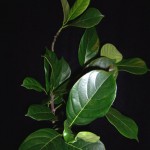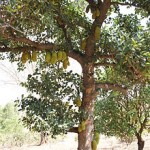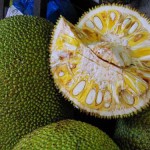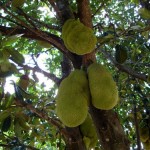Artocarpus heterophyllus
Family: Moraceae
Tribe: Artocarpeae
Genus: Artocarpus
Botanical name: A. heterophyllus
Vernacular Name: Jak(E), Kos(S),Pla(T)
Synonyms:
Artocarpus brasiliensis Ortega
Artocarpus integrifolia var. glabra Stokes
Articarpus integrifolia var. heterophylla (Lam.) Pers.
Artocarpus maximus Blanco
Artocarpus nanca Noronha [Invalid]
Artocarpus philippensis Lam.
Polyphema jaca Lour.
Saccus arboreus major Rumph.
Sitodium cauliflorum Gaertn.
Tsjaka-maram Rheede
Artocarpus heterophyllus or Jackfruit plants are native from India to the Malay Peninsula. They are large trees often reaching 60 feet (20 m) in nature. The smooth brownish-grey trunks are very straight. Stiff and glossy leaves are elliptical to ovate, up to 8 inches (20 cm) long and about half as wide. The fruit of the tree is the largest fruit. Fruits will reach up to 36 inches (~1 m) and approximately 20 inches (50 cm) in diameter, weighing up to 80 pounds. The trees are hardy only in USDA zones 10-11.
Blooming: Although our plants have flowered, they have never produced fruit. Male and female flowers are in separate flower heads. Male flowers are produced on new wood above the female flowers. Female flowers are formed on short, stout twigs that emerge from the trunks and large limbs.
Culture: Artocarpus heterophyllus need need full sun, warm temperatures, and a rich, moist well-drained soil mix. In the greenhouse, we use a soil mix consisting of 2 parts peat moss to 1 part loam to 2 parts sand or perlite. The plants are kept moist at all times. The plants do not withstand drought. We fertilize our plants monthly with a balanced fertilizer diluted to ½ the strength recommended on the label. The trees are fairly fast growers and need to be pruned regularly to keep them within bounds in the greenhouse. This might be the reason why we do not produce fruit. During the winter months water is somewhat restricted, but the trees are never allowed to completely dry out.
Propagation: Artocarpus heterophyllus is propagated from seed. Seeds remain viable for no longer than one month. Fresh seed will germinate in 21 to 45 days at 80°F (27°C). Seedlings should be transplanted when plants have four leaves present. Plants with more than 4 leaves are very difficult to transplant.
Uses: Wood is locally used. The roots are highly valued for carving and picture framing. Burned leaf ashes mixed with coconut oil are used to treat scabies. The fruits and seeds are edible.
Distribution: Widely cultivated throughout the tropics,especially in southeast Asia,common in Srilanka;origin unknown, possibly South India.
Ecology: Fruit-crop March-April.
Uses: Fruit;timber.
Chemical Compounds:

![500_artocarpus_heterophyllus[hc673]12188b](http://science.cmb.ac.lk/tools/slflora/wp-content/uploads/2012/11/500_artocarpus_heterophyllushc67312188b-150x150.jpg)







